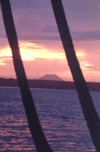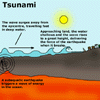 As we walked along the idyllic waters edge on this most beautiful
evening, the ground shook, nearby coconut trees shuddered and a coconut
fell to the ground. Not really a large guria (earthquake) as they go here
in Rabaul on the island of East New Britain, Papua New Guinea, but enough
to make us look towards the centre of the harbour to see if the tropical
waters of this sunken volcano were going to react.
As we walked along the idyllic waters edge on this most beautiful
evening, the ground shook, nearby coconut trees shuddered and a coconut
fell to the ground. Not really a large guria (earthquake) as they go here
in Rabaul on the island of East New Britain, Papua New Guinea, but enough
to make us look towards the centre of the harbour to see if the tropical
waters of this sunken volcano were going to react.
Then came a cry from down along the shore, the water was draining from
the mud flats near the pier. Seconds later hundreds of metres of mud flats
lay exposed; we did not stay around to see the incoming wave. Was it going
to crush us all as it swept through the town?
Tsunamis or tidal waves are probably the least understood natural phenomenon
associated with movements of the Earth's crust. The word "tsunami"
is Japanese, meaning "harbour waves". This is as misleading
as "tidal waves", as tsunamis don't occur in harbours nor are
in any way associated with tides.
The occurrence of tsunamis
Tsunamis (soo NAH mee) mainly occur when underwater earthquakes create
vertical movement in the ocean floor. Tsunamis can also be caused by any
event which causes movement in the water. Landslides, volcanic eruptions,
explosions, the impact of asteroids and meteors all can create tsunamis.

As the bulge of water created by the initial disturbance settles back
down, a series of waves can be created travelling at speeds of over 770km/hr.
In the deep ocean, tsunamis may pass unnoticed under ships as their height
is usually less than a metre. It is when they reach shallow water that
their energy is fully released.
Upon reaching the shoreline, the energy of the tsunami can create a series of high waves, crashing down on the shore destroying all in its path. A tsunami of this magnitude, created by an earthquake in Alaska, sent waves across the Pacific to inundate parts of coastal Japan and Hawaii, washing large boats hundreds of metres inland.
Not all tsunami waves break as they hit land, they simply surge ashore, flooding low-lying areas and rebounding off cliffs and high land, causing more damage as they move back out to sea. Large tsunamis can reverberate around an ocean for days as occurred in 1960, when an off-shore earthquake near Chile sent tsunami waves in all directions across the Pacific Ocean, causing a 6m tsunami in Japan 22 hours later. The tsunami continued to criss-cross the Pacific for days, causing damage whenever it struck land.
One of the most recent and widely publicised tsunami was the one that hit Sissino, Papua New Guinea in July 1998. This tsunami generated by a undersea volcanic eruption caused the deaths of many villagers and destruction of their villages.
Fortunately, tsunami of this size are rare. Much more common are those of the type which formed on that evening in Rabaul. A small wave, maybe 1m high, swept back across the mudflats coming to a halt on the sea wall and beaches. Just another day in paradise!
Tsunamis in Australia
Tsunamis are much rarer in Australia. They are not unknown though. On June 3, 1994, a killer tsunami
forced its way along the Indian Ocean coastline of Java, Indonesia, killing 200 people, and
continued on to hit the Australian coastline at Broome, King Bay, Onslow and Carnarvon,
Western Australia. The tsunami reached 3 - 4 meters high. In southern
New South Wales, tsunamis are believed to have tossed rocks weighing up
to 90 tonnes on to cliffs 30 metres high. Some scientists have suggested
that tsunamis of this magnitude have occurred as regularly as once every
200 years along the New South Wales coastline, although none have been
experienced in the past 200 plus years of European settlement!
In Australia, tsunami models predict that the north-west coast of Western Australia is most susceptible to tsunamis. Parts of the east coast thought to be vulnerable include the south and central coasts of New South Wales. In Queensland, the Great Barrier Reef may not provide protection from tsunamis. Scientists have found evidence of tsunamis having come through gaps in the reef depositing huge coral boulders on shore.
| Copyright owned by the State of Victoria (Department of Education and Early Childhood Development). Used with Permission. |
|
|||||||||||||||||||||||